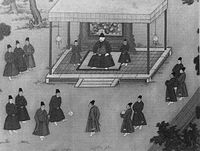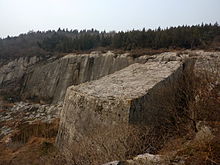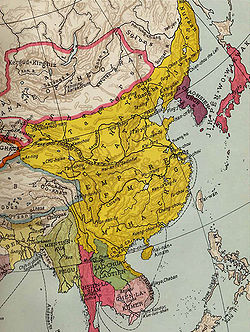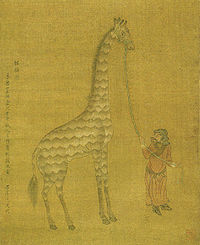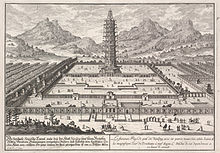- Yongle Emperor
-
Yongle Emperor 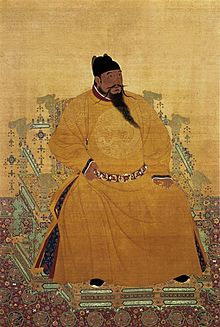
Emperor of China Reign 17 July 1402 - 12 August 1424 (22 years, 26 days) Predecessor Jianwen Emperor Successor Hongxi Emperor Spouse Empress Ren Xiao Wen Concubine Noble Consort Zhao Xian
Noble Consort Zhao Yi
Consort Gong Xian Xian
Consort Zhong Jing Zhao Shun Xian
Consort Kang Mu Yi Gong Hui
Consort Gong Shun Rong Mu Li
Consort Kang Jing Zhuang He Hui
Consort Duan Jing Gong Hui Shu
Consort Gong He Rong Shun Xian
Consort Zhao Su Jing Hui Xian
Consort Zhao Hui Gong Yi Shun
Consort Hui Mu Zhao Jing Shun
Consort Kang Hui Zhuang Shu Li
Consort An Shun Hui
Consort Gong Yi Hui
Consort Zhao Shun De
Consort Kang Yi Shun
Consort Hui Mu Shun
Consort Zhen Jing Shun
Consort Shun
Lee Zhaoyi
Ryeo Jieyu
Beauty Lady Choi
Beauty Lady Gong Rong
Beauty Lady Jing Hui
Beauty Lady Zhuang HuiIssue Zhu Gaochi, Hongxi Emperor
Princess Yong'an
Princess Yongping
Zhu Gaoxu, Prince of Han
Zhu Gaosui, Prince Jian of Zhao
Princess Ancheng
Princess Xianning
Princess Changning
Zhu GaoxiFull name Family name: Zhu (朱)
Given name: Di (棣)Era name and dates Yǒnglè (永樂): 23 January 1403 – 19 January 1425 Posthumous name Emperor Qitian Hongdao Gaoming Zhaoyun Shengwu Shengong Chunren Zhixiao Wen
啓天弘道高明肇運聖武神功純仁至孝文皇帝Temple name Míng Chéngzǔ[1]
明成祖House House of Zhu Father Hongwu Emperor Mother Empress Xiao Ci Gao Born 2 May 1360
Yingtian, Yuan EmpireDied 12 August 1424 (aged 64)
Yumuchuan, Inner MongoliaBurial Changling, Ming Dynasty Tombs, Beijing The Yongle Emperor (Traditional Chinese: 永樂; Simplified Chinese: 永乐; pinyin: Yǒnglè; Wade-Giles: Yung-lo; IPA: [jʊ̀ŋlɤ̂]) (2 May 1360 – 12 August 1424), born Zhu Di (Chu Ti), was the third emperor of the Ming Dynasty of China from 1402 to 1424. His Chinese era name Yongle means "Perpetual Happiness".
He was the Prince of Yan (燕王), possessing a heavy military base in Beiping. He became known as Chengzu of Ming Dynasty (明成祖 also written Cheng Zu, or Ch'eng Tsu (Cheng Tsu) in Wade-Giles) after becoming emperor (self title). He became emperor by conspiring to usurp the throne which was against Hongwu Emperor's wishes.
He moved the capital from Nanjing to Beijing where it was located in the following generations, and constructed the Forbidden City there. After its dilapidation and disuse during the Yuan Dynasty and Hongwu's reign, the Yongle Emperor had the Grand Canal of China repaired and reopened in order to supply the new capital of Beijing in the north with a steady flow of goods and southern foodstuffs. He commissioned most of the exploratory sea voyages of Zheng He. During his reign the monumental Yongle Encyclopedia was completed. Although his father Zhu Yuanzhang was reluctant to do so when he was emperor, Yongle upheld the civil service examinations for drafting educated government officials instead of using simple recommendation and appointment.
The Yongle Emperor is buried in the Changling (長陵, "Long Mausoleum") tomb, the central and largest mausoleum of the Ming Dynasty Tombs.
Contents
Early years
The Yongle Emperor was born Zhu Di on 2 May 1360, the fourth son of the new leader of the central Red Turbans, Zhu Yuanzhang, who would later rise to become the Hongwu Emperor, the first emperor of the Ming Dynasty. Although Zhu Di would always claim that his mother was the Empress Ma (Zhu Yuanzhang's primary wife), his real birth mother is speculated by some to have been a secondary queen consort of either Korean or Mongolian origin.[2]Zhu Di grew up as a prince in a loving, caring environment. His father supplied nothing but the best education for his sons and eventually gave them their own princedoms. Zhu Di was entitled as the Prince of Yan, the area around Beijing.
When Zhu Di moved to Beijing, he found a city that had been devastated by famine and disease and that was under threat of invasion from Mongols from the north. The Mongols had ruled over Beijing, or Dadu, as it was then called, under the Yuan Dynasty from 1271 to 1368 but had been expelled from the city by Zhu Di's father, Zhu Yuangzhang with the help of General Xu Da. Xu Da also helped Zhu Di, who was his son-in law, to secure the northern borders.
Zhu Di had been very successful against the Mongols and impressed his father with his energy, risk-taking ability and leadership. Even Zhu Di's troops praised his effectiveness, especially when Emperor Hongwu rewarded them for their service. But Zhu Di was not the oldest brother, forcing his father to name Zhu Biao, the Prince of Jin, as the crown prince. When the Prince of Jin died of illness in 1392, worries of imperial succession ensued.
Journey to power
The Hongwu Emperor died on June 24, 1398. His grandson Zhu Yunwen, the son of the late Zhu Biao, was crowned as the Jianwen Emperor. Zhu Di and Jianwen began a deadly feud. When Zhu Di traveled with his guards to pay tribute to his father, Jianwen took his actions as a threat and sent troops to repel him. Zhu Di was forced to leave in humiliation. Jianwen persisted in refusing to let Zhu Di see his father's tomb; Zhu Di challenged the emperor's judgment. Zhu Di quickly became the biggest threat to the imperial court. Jianwen tried to avoid direct contact with Zhu Di as much as possible. To achieve this, he abolished the lesser princedoms to undermine Zhu Di's power and create room in which to plant his own loyal generals. Zhu Di was soon surrounded by Jianwen's generals, and cautiously reacted to the political gridlock in which he found himself. His rebellion slowly began to take shape.
Zhu Di's leading rebellion slogan was self defense known as the Jingnan Campaign (靖難之役). This was enough to earn him strong support from the populace and many supporting generals. He was a great military commander and studied Sun Tzu's Art of War extensively. He used surprise, deception, and caution and even tactics such as enlisting several Mongolian regiments to aid him in fighting Jianwen. He defeated Li Jinglong, a loyalist general, several times, deceiving him and overwhelming him in many decisive battles. On January 15, 1402 Zhu Di made the bold decision to march his army straight to Nanjing, encountering stiff resistance. But his decision proved successful, forcing an imperial retreat to protect the defenseless residence of Jianwen. When Zhu Di reached the capital city, the frustrated and disgraced General Li Jinglong opened the doors and permitted Zhu Di's army to freely enter. In the widespread panic caused by the sudden entry, the emperor's palace caught fire. Jianwen and his wife disappeared, most likely falling victim to the fire.[3][4][5]
Having ended Jianwen's reign, Zhu Di and his administration spent the latter part of 1402 brutally purging China of Jianwen's supporters. Such an action was believed to be required to pacify China and maintain his rule. He ordered all records of the four-year-reign of Jianwen Emperor to be dated as year 32 through year 35 of the Hongwu Emperor, in order to establish himself as the legitimate successor of the Hongwu Emperor.
On July 17, 1402, after a brief visit to his father's tomb, Zhu Di was crowned Emperor Yongle at the age of 42. He would spend most of his early years suppressing rumors, stopping bandits, and healing the wounds of the land scarred by rebellion.
Extermination of the ten agnates
Zhu Di has been credited with ordering perhaps the only case of "extermination of the ten agnates" (誅十族) in the history of China. For nearly 1500 years of feudal China, the Nine exterminations (誅九族) is considered one of the most severe punishments found in traditional Chinese law enforced until the end of Qing. The practice of exterminating the kin had been established since the Qin when Emperor Qin Shi Huang (reigned 247 BC–221 BC) declared "Those who criticize the present with that of the past: Zu" (以古非今者族). Zu (族) referred to the "extermination of three agnates" (三族): father, son and grandson. The extermination was to ensure the elimination of challenges to the throne and political enemies. Emperor Yang (reigned 604–617) extended it to the nine agnates. The nine agnates are the four senior generations to the great-great-grandfather and four junior generations to the great-great-grandson. The definition also included siblings and cousins related to each of the nine agnates.
Just before the accession of Emperor Yongle, prominent historian Fang Xiaoru (方孝孺) elicited the offense worthy of the "extermination of nine agnates" for refusing to write the inaugural address and for insulting the Emperor. He was recorded as saying in defiance to the would-be Emperor: "莫說九族,十族何妨!" ("Nevermind nine agnates, go ahead with ten!"). Thus he was granted his wish with perhaps the only and infamous case of "extermination of ten agnates" in the history of China. In addition to the blood relations from his nine-agnates family hierarchy, his students and peers were added to be the 10th group.
Reign
Yongle followed traditional rituals closely and remained superstitious. He did not overindulge in the luxuries of palace life, but still used Buddhism and Buddhist festivals to overcome some of the backwardness of the Chinese frontier and to help calm civil unrest. He stopped the warring between the various Chinese tribes and reorganized the provinces to best provide peace within China. Yongle was said to be an "ardent Buddhist" by Ernst Faber.[6]
Due to the stress and overwhelming amount of thinking involved in running a post-rebellion empire, Yongle searched for scholars to join his staff. He had many of the best scholars chosen as candidates and took great care in choosing them, even creating terms by which he hired people. He was also concerned about the degeneration of Buddhism in China.
Yongle and Tibet
In 1403, Yongle sent messages, gifts, and envoys to Tibet inviting Deshin Shekpa, the fifth Gyalwa Karmapa of the Kagyu school of Tibetan Buddhism, to visit China — apparently after having a vision of Avalokitesvara. After a long journey, Deshin Shekpa arrived in Nanjing on April 10, 1407 riding on an elephant towards the imperial palace, where tens of thousands of monks greeted him.
He convinced the emperor that there were different religions for different people, which does not mean that one is better than the other. The Karmapa was very well received in China and a number of miraculous occurrences were reported. He also performed ceremonies for the emperor's family. The emperor presented him with 700 measures of silver objects and bestowed the title of 'Precious Religious King, Great Loving One of the West, Mighty Buddha of Peace'.[7]
Aside from the religious matters, the Emperor wished to establish an alliance with the Karmapa similar to the one the Yuan (1277–1367) rulers had established with the Sakyapa.[8] He apparently offered to send armies to unify Tibet under the Karmapa but Deshin Shekpa refused this offer.[9]
Deshin left Nanjing on 17 May 1408.[10] In 1410 he returned to Tsurphu where he had his monastery rebuilt which had been severely damaged by an earthquake.
Choosing the heir
When it was time for him to choose an heir, Yongle very much wanted to choose his second son, Gaoxu. Gaoxu was an athletic warrior type that contrasted sharply with his older brother's intellectual and humanitarian nature. Despite much counsel from his advisors, Yongle chose his older son, Gaochi (the future Hongxi Emperor), as his heir apparent mainly due to advice from Xie Jin. As a result, Gaoxu became infuriated and refused to give up jockeying for his father's favor and refusing to move to Yunnan province (of which he was prince). He even went so far as to undermine Xie Jin's council and eventually killed him.
National economy and construction projects
After Yongle's overthrow of Jianwen, China's countryside was devastated. The fragile new economy had to deal with low production and depopulation. Yongle laid out a long and extensive plan to strengthen and stabilize the new economy, but first he had to silence dissension. He created an elaborate system of censors to remove corrupt officials from office that spread such rumors. Yongle dispatched some of his most trusted officers to reveal or destroy secret societies, Jianwen loyalists, and even bandits. To strengthen the economy, he was forced to fight population decline by reclaiming land, utilizing the most he could from the Chinese people, and maximizing textile and agricultural production.
Yongle also worked to reclaim production rich regions such as the Lower Yangtze Delta and called for a massive reconstruction of the Grand Canal of China. During his reign, the Grand Canal was almost completely rebuilt and was eventually moving imported goods from all over the world. Yongle's short-term goal was to revitalize northern urban centers, especially his new capital at Beijing. Before the Grand Canal was rebuilt, grain was transferred to Beijing in two ways; one route was simply via the East China Sea, from the port of Liujiagang (near Suzhou); the other was a far more laborious process of transferring the grain from large to small shallow barges (after passing the Huai River and having to cross southwestern Shandong), then transferred back to large river barges on the Yellow River before finally reaching Beijing.[11] With the necessary tribute grain shipments of 4 million shi (one shi equal to 107 liters) to the north each year, both processes became incredibly inefficient.[11] It was a magistrate of Jining, Shandong who sent a memorandum to Yongle protesting the current method of grain shipment, a wise request that Yongle ultimately granted.[12]
Yongle ambitiously planned to move China's capital to Beijing. According to a popular legend, the capital was moved when the emperor's advisers brought the emperor to the hills surrounding Nanjing and pointed out the emperor's palace showing the vulnerability of the palace to artillery attack.
He planned to build a massive network of structures in Beijing in which government offices, officials, and the imperial family itself resided. After a painfully long construction time, the Forbidden City was finally completed and became the political capital of China for the next 500 years.
Yongle finalized the architectural ensemble of his father's Ming Xiaoling Mausoleum in Nanjing be erecting a monumental "Square Pavilion" (Sifangcheng) with an 8-meter-tall tortoise-borne stele, extolling the merits and virtues of the Hongwu Emperor. In fact, Yongle's original idea for the memorial was to erect an unprecedented stele 73 m tall. However, due to the impossibility of moving or erecting the giant parts of that monuments, they have been left unfinished in Yangshan Quarry, where they remain to this day.[13]
Even though the Hongwu Emperor may have meant for his descendants to be buried near his own Xiaoling Mausoleum (this is how Hongwu's heir apparent, Zhu Biao was buried), Yongle's relocation of the capital to Beijing necessitated the creation of a new imperial burial ground. On advice of feng shui experts, the Yongle Emperor chose a site north of Beijing, where he and his successors were to be buried. Over the next two centuries, thirteen emperors in total were laid to rest in these Ming Dynasty Tombs.
Religion and philosophy
Yongle sponsored and created many cultural traditions in China. He promoted Confucianism and kept traditional ritual ceremonies with a rich cultural theme. His respect for Chinese culture was apparent. He commissioned his Grand Secretary, Xie Jin, to write a compilation of every subject and every known book of the Chinese. The massive project's goal was to preserve Chinese culture and literature in writing. The initial copy took 17 months to transcribe and another copy was transcribed in 1557. The book, named the Yongle Encyclopedia, is still considered one of the most marvelous human achievements in history, despite it being gradually lost by time.
Yongle's tolerance of Chinese ideas that did not agree with his own philosophies was well-known. He treated Daoism, Confucianism, and Buddhism equally (though he favored Confucianism). Strict Confucianists considered him hypocritical, but his even handed approach helped him win the support of the people and unify China. His love for Chinese culture sparked a sincere hatred for Mongolian culture. He considered it rotten and forbade the use of popular Mongolian names, habits, language, and clothing. Great lengths were taken by Yongle to eradicate Mongolian culture from China.
Yongle called for the construction and repair of Islamic mosques during his reign. Two mosques were built by him, one in Nanjing and the other in Xi'an and they still stand today. Repairs were encouraged and the mosques were not allowed to be converted to any other use.[14][15]
Military accomplishments
Mongol invaders were still causing many problems for the Ming Dynasty. Yongle prepared to change this tradition. He mounted five military expeditions into Mongolia and crushed the remnants of the Yuan Dynasty that had fled north after being defeated by Emperor Hongwu. He repaired the northern defenses and forged buffer alliances to keep the Mongols at bay in order to build an army. His strategy was to force the Mongols into economic dependence on the Chinese and to launch periodic initiatives into Mongolia to cripple their offensive power. He attempted to compel Mongolia to become a Chinese tributary, with all the tribes submitting and proclaiming themselves vassals of the Ming, and wanted to contain and isolate the Mongols. Through fighting, Yongle learned to appreciate the importance of cavalry in battle and eventually began spending much of his resources to keep horses in good supply. Yongle spent his entire life fighting the Mongols. Failures and successes came and went, but it should be noted that after Yongle's second personal campaign against the Mongols, the Ming Dynasty was at peace for over seven years.
Vietnam was a significant source of difficulties during Yongle's reign. In 1406, The Yongle Emperor responded to several formal petitions from members of the (now deposed) Trần Dynasty, however on arrival to Vietnam, both the Tran prince and the accompanying Chinese ambassador were ambushed and killed. In response to this insult the Yongle Emperor sent a huge army of 500,000 south to conquer Vietnam. As the royal family were all executed by the Ho monarchs Vietnam was integrated as a province of China, just as it had been up until 939. With the Ho monarch defeated in 1407 the Chinese began a serious and sustained effort to Sinicize the population. Unfortunately for the Chinese, their efforts to make Vietnam into a normal province met with a significant resistance from the local population. Several revolts started against the Chinese rulers. In early 1418 a major revolt was begun by Lê Lợi, the future founder of the Lê Dynasty. By the time the Yongle Emperor died in 1424 the Vietnamese rebels under Lê Lợi's leadership had captured nearly the entire province. By 1427 the Xuande Emperor gave up the effort started by his grandfather and formally acknowledged Vietnam's independence.
Diplomatic missions and exploration of the world
As part of his desire to expand Chinese influence throughout the known world, Emperor Yongle sponsored the massive and long term Zheng He expeditions. While Chinese boats continued traveling to Japan, Ryukyu, and many location in South-East Asia both before and after the Yongle era, Zheng He's expeditions were China's only major sea-going explorations of the world (although the Chinese may have been sailing to Arabia, East Africa, and Egypt since the Tang Dynasty, from AD 618-907[17] or earlier). The first expedition was launched in 1405 (18 years before Henry the Navigator began Portugal's voyages of discovery). The expeditions were under the command of eunuch Zheng He and his associates (Wang Jinghong, Hong Bao, etc.). Seven expeditions were launched between 1405 and 1433, reaching major trade centers of Asia (as far as Tenavarai (Dondra Head), Hormuz and Aden) and north-eastern Africa (Malindi). Some of the boats used were apparently the largest sail-powered wooden boats in human history (National Geographic, May 2004).
The Chinese expeditions were a remarkable technical and logistical achievement. Zhu Di's successors, the Hongxi Emperor and the Xuande Emperor, felt that the costly expeditions were harmful to the Chinese state. The Hongxi Emperor ended further expeditions and the descendants of the Xuande Emperor suppressed much of the information about the Zheng He voyages.
In 1411, a smaller fleet, built in Jilin and commanded by another eunuch Yishiha, sailed down the Sungari and Amur Rivers. The expedition established a Nurgan Regional Military Commission in the region, headquartered at the place the Chinese called Telin (特林) (now the village of Tyr, Russia). The local Nivkh or Tungusic chiefs were granted ranks in the imperial administration. Yishiha's expeditions returned to the lower Amur several more times during the reigns of Yongle and Xuande, the last one visiting the region in the 1430s.[18][19]
After the death of Timur, who intended to invade China, the relations between the Yongle Emperor's China and Shakhrukh's state in Persia and Transoxania state considerably improved, and the countries exchanged large official delegations on a number of occasions. Both the Chinese envoy to Samarkand and Herat, Chen Cheng, and his opposite party, Ghiyasu'd-Din Naqqah left detailed accounts of their visits to each other's country.
One of his wives was a Jurchen princess, which resulted in many of the eunuchs serving him being of Jurchen origin, notably Yishiha.[20]
Death
On April 1, 1424, Yongle launched a large campaign into the Gobi Desert to chase a nuisance army of fleeting Tatars. Yongle became frustrated at his inability[citation needed] to catch up with his swift opponents and fell into a deep depression[citation needed] and then into illness[citation needed] (suffered a series of minor strokes) . On August 12, 1424, the Yongle Emperor died. He was entombed in Chang-Ling (長陵), a location northwest of Beijing.
Legacy
Many have seen Yongle as in a life-long pursuit of power, prestige, and glory. He respected and worked hard to preserve Chinese culture by designing monuments such as the Porcelain Tower of Nanjing, while undermining and cleansing Chinese society of foreign cultures. He deeply admired and wished to save his father's accomplishments and spent a lot of time proving his claim to the throne. His military accomplishments and leadership are rivaled by only a handful of people in world history. His reign was a mixed blessing for the Chinese populace. Yongle's economic, educational, and military reforms provided unprecedented benefits for the people, but his despotic style of government set up a spy agency. Despite these negatives, he is considered an architect and keeper of Chinese culture, history, and statecraft and an influential ruler in Chinese history.
He may have suffered from undisclosed impotence in his later life. He is remembered very much for his cruelty, just like his father. He killed most of the Jian Wen palace servants, tortured many Jianwen Emperor loyalists to death, killed or by other means badly treated their relatives.[21][22][23][24] His successor emperor freed most of them alive. In 1420, he ordered 2,800 ladies-in-waiting to a slow slicing death, and watched, because he thought one of his favourite Joseon concubine had been poisoned.[25] However, unlike his father, he did not kill most of his generals, and he entrusted power to eunuchs like Zheng He, with serious consequences for subsequent Ming emperors. He showed some regrets over his cruelty, built the Yongle bell, but still had about thirty beautiful women hanged to be buried with him after he died.[26]
Personal information
- Father
- Mother
- Empress Xiao Ci Gao
Consorts
Formal Title Maiden Name Born Died Father Mother Issue Notes Empress Ren Xiao Wen
仁孝文皇后Family name: Xu (徐)
Given name: Yihua (儀華)1362
Yingtian, Yuan EmpireJuly 1407
Nanjing, Ming EmpireXu Da
徐達Lady Xie
謝氏Zhu Gaochi, Hongxi Emperor
Zhu Gaoxu, Prince of Han
Zhu Gaosui, Prince Jian of Zhao
Princess Ancheng
Princess XianningNoble Consort Zhao Xian
昭獻貴妃Family name: Wang (王) Suzhou, Jiangsu Province 1420 - - none Entered the imperial court in 1409 Noble Consort Zhao Yi
昭懿貴妃Family name: Zhang (張) - - Zhang Yu
張玉- none Consort Gong Xian Xian
恭獻賢妃Family name: Gwon (權) 1391
Joseon1410 Gwon Yeong-gyun
權永均 or 우익은- none Was Korean Consort Zhong Jing Zhao Shun Xian
忠敬昭順賢妃Family name: Yu (喻) - - - 1421 none Consort Kang Mu Yi Gong Hui
康穆懿恭惠妃Family name: Wu (吳) - - - - Zhu Gaoxi Consort Gong Shun Rong Mu Li
恭順榮穆麗妃Family name: Chen (陳) - - Chen Mao, Marquess of Ningyang
寧陽侯陳懋- none Consort Kang Jing Zhuang He Hui
康靖莊和惠妃Family name: Cui (崔) - - - - none Consort Duan Jing Gong Hui Shu
端靜恭惠淑妃Family name: Yang (楊) - - - - none Consort Gong He Rong Shun Xian
恭和榮順賢妃Family name: Wang (王) - - - - none Consort Zhao Su Jing Hui Xian
昭肅靖惠賢妃Family name: Wang (王) - - - - none Consort Zhao Hui Gong Yi Shun
昭惠恭懿順妃Family name: Wang (王) - - - - none Consort Hui Mu Zhao Jing Shun
惠穆昭敬順妃Family name: Qian (錢) - - - - none Consort Kang Hui Zhuang Shu Li
康惠莊淑麗妃Family name: Han (韓) Joseon - Han Yeong-jeong
韓永矴 or 한영정[27]- none Was one of the 30 beautiful women who were buried with the Yongle Emperor after his death Consort An Shun Hui
安順惠妃Family name: Long (龍) - - - - none Consort Gong Yi Hui
恭懿惠妃Family name: Zhao (趙) - - - - none Consort Zhao Shun De
昭順德妃Family name: Liu (劉) - - - - none Consort Kang Yi Shun
康懿順妃Family name: Li (李) - - - - none Consort Hui Mu Shun
惠穆順妃Family name Guo (郭) - - - - none Consort Zhen Jing Shun
貞靜順妃Family name: Zhang (張) - - - - none Consort Shun
順妃Family name: Im (任) Joseon - - - none Was Korean Lee Zhaoyi
昭儀李氏Family name: Lee (李) Joseon - - - none Was Korean Ryeo Jieyu
婕妤呂氏Family name: Ryeo (呂) Joseon - - - none Was Korean Beauty Lady Choi
美人崔氏Family name: Choi (崔) Joseon - - - none Was Korean Beauty Lady Gong Rong
恭榮美人Family name: Wang (王) - - - - none Beauty Lady Jing Hui
景惠美人Family name: Lu (盧) - - - - none Initially Beauty Lady Gong Hui (恭惠美人) Beauty Lady Zhuang Hui
莊惠美人unknown - - - - none Sons
Number Name Formal Title Born Died Mother Spouse Issue Notes 1 Zhu Gaochi
朱高熾The Hongxi Emperor 16 August 1378 29 May 1425 Empress Ren Xiao Wen Lady Zhang, Empress Cheng Xiao Zhao
11 concubinesZhu Zhanji, Xuande Emperor
Zhu Zhanxun, Prince Jing of Zheng
Zhu Zhanyong, Prince Jing of Yue
Zhu Zhanyin, Prince Xian of Qi
Zhu Zhanshan, Prince Xian of Xiang
Zhu Zhangang, Prince Xian of Jing
Zhu Zhanyu, Prince Jing of Huai
Zhu Zhankai, Prince Huai of Teng
Zhu Zhanji, Prince Zhuang of Liang
Zhu Zhanyan, Prince Gong of Wei
Princess Jiaxing
Zhu Yuantong, Princess Qingdou
Princess Qinghe
Princess De'an
Princess Yanping
Princess Deqing
Princess Zhending2 Zhu Gaoxu
朱高煦Prince of Han
漢王30 December 1380 6 October 1426 Empress Ren Xiao Wen Consort Wei
韋妃Zhu Zhanhe, Heir Apparent Yi Zhuang
Zhu Zhanqi, Heir Apparent
Zhu Zhanci, Prince of Jiyang
Zhu Zhanyu, Prince of Linzi
Zhu Zhanyi, Prince Zichuan
Zhu Zhanxing, Prince of Changle
Zhu Zhanping, Prince of Qidong
Zhu Zhandao, Prince of Rencheng
Zhu Zhanchang, Prince of Haifeng
Zhu Zhanbang, Prince of Xintai3 Zhu Gaosui
朱高燧Prince Jian of Zhao
趙簡王19 January 1383 5 October 1431 Empress Ren Xiao Wen Lady Xu
(daughter of Xu Zhang (徐章))
Lady Mu
(daughter of Mu Cheng (沐晟))Zhu Zhanba, Heir Apparent Daoxi of Zhao
Zhu Zhanque, Prince Hui of Zhao
a sonCreated Prince of Zhao on 12 May 1404 4 Zhu Gaoxi
朱高爔- 18 January 1392 February 1392 Consort Kang Mu Yi Gong Hui none none Died one month after his birth Daughters
Number Title Born Died Date Married Spouse Issue Mother Notes 1 Princess Yong'an
永安公主- 1417 1395 Yuan Rong, Marquess of Guangping
廣平侯袁容Yuan Bei
袁貝Empress Ren Xiao Wen 2 Princess Yongping
永平公主1379 22 April 1444 1395 Li Rang, Marquess of Fuyang
富陽侯李讓
(son of Li Shen (李申))Li Maofang
李茂芳Empress Ren Xiao Wen 3 Princess Ancheng
安成公主1384 16 September 1443 1402 Song Hu
宋琥
(second son of Song Cheng, Marquess of Xining)- Empress Ren Xiao Wen 4 Princess Xianning
咸寧公主1385 27 July 1440 1403 Song Ying
宋瑛
(third son of Song Cheng, Marquess of Xining)- Empress Ren Xiao Wen 5 Princess Changning
常寧公主1386 5 April 1408 20 June 1403 Mu Xin
沐昕
(son of Mu Ying, Marquess of Xiping)- - Footnotes
- ^ The original temple name was Taizong (太宗), but it was changed in 1538 into Chengzu.
- ^ Levathes, Louise, When China Ruled The Seas: The Treasure Fleet of the Dragon Throne 1405-1433 (New York; Oxford University Press, 1994) pg 59
- ^ 吕毖, 明朝小史, vol.3
- ^ 谷應泰, 明史紀事本末, vol.16
- ^ 学者论建文事·孟森《万季野<明史稿>辩诬》[附〔清〕钱大昕《万斯同先生传》]
- ^ Ernst Faber (1902). Chronological handbook of the history of China: a manuscript left by the late Rev. Ernst Faber. Pub. by the General Evangelical Protestant missionary society of Germany. p. 196. http://books.google.com/books?id=sEYPAAAAYAAJ&q=ardent+buddhist#v=snippet&q=ardent%20buddhist%20reaching&f=false. Retrieved 2011-06-6.
- ^ Brown, 34.
- ^ Sperling, 283–284.
- ^ Brown, 33–34.
- ^ Sperling, 284.
- ^ a b Brook, 46–47.
- ^ Brook, 47.
- ^ Yang, Xinhua (杨新华); Lu, Haiming (卢海鸣) (2001), 南京明清建筑 (Ming and Qing architecture of Nanjing), 南京大学出版社 (Nanjing University Press), pp. 595-599,616-617, ISBN 7-305-03669-2
- ^ China archaeology and art digest, Volume 3, Issue 4. Art Text (HK) Ltd. 2000. p. 29. http://books.google.com/books?ei=B4k2TLyUGcO88gaN09GwAw&ct=result&id=0UzrAAAAMAAJ&dq=yongle+1407+edict+muslims+china&q=edict+1407. Retrieved 2010-06-28.
- ^ Dru C. Gladney (1996). Muslim Chinese: ethnic nationalism in the People's Republic. Harvard Univ Asia Center. p. 269. ISBN 0674594975. http://books.google.com/books?id=_hJ9aht6nZQC&pg=PA269&dq=yongle+1407+edict+muslims+china&hl=en&ei=B4k2TLyUGcO88gaN09GwAw&sa=X&oi=book_result&ct=result&resnum=1&ved=0CCgQ6AEwAA#v=onepage&q=yongle%201407%20edict%20&f=false. Retrieved 2010-06-28.
- ^ Duyvendak, J.J.L. (1939), "The True Dates of the Chinese Maritime Expeditions in the Early Fifteenth Century The True Dates of the Chinese Maritime Expeditions in the Early Fifteenth Century", T'oung Pao, Second Series 34 (5): 402, http://www.jstor.org/stable/4527170
- ^ Based on descriptions of the coast from 860. Ronan, Colin; Needham, Joseph (1986), The Shorter Science and Civilisation in China, 3, p. 133
- ^ L. Carrington Godrich, Chaoying Fang (editors), "Dictionary of Ming Biography, 1368-1644". Volume I (A-L). Columbia University Press, 1976. ISBN 0-231-03801-1. (Article on Ishiha, pp. 685-686)
- ^ Tsai (2002), pp. 158-159.
- ^ Taisuke Mitamura (1970). Chinese eunuchs: the structure of intimate politics. C.E. Tuttle Co.. p. 54. http://books.google.com/books?id=SGAbAAAAYAAJ&q=During+the+Ming+dynasty,+Emperor+Yung+Le,+a+man+of+eccentric+tastes,+acquired+a+princess+from+the+Tungusic+Nu+Chen+tribe,+so+there+were+a+large+number+of+eunuchs+drawn+from+the+Nu+Chen+people.&dq=During+the+Ming+dynasty,+Emperor+Yung+Le,+a+man+of+eccentric+tastes,+acquired+a+princess+from+the+Tungusic+Nu+Chen+tribe,+so+there+were+a+large+number+of+eunuchs+drawn+from+the+Nu+Chen+people.&hl=en&ei=L-vMTLjeCYT7lweK_ICbBg&sa=X&oi=book_result&ct=result&resnum=1&ved=0CCgQ6AEwAA. Retrieved 2010-06-28.
- ^ Bo Yang, 中國人史綱, ch.28
- ^ 宋端儀, 立齋閑錄, vol.2
- ^ 陸人龍, 型世言, ch.1
- ^ 建文帝出亡宁德之谜揭秘八:建文帝出亡闽东金邶寺
- ^ 李朝實錄太宗實錄
- ^ 李朝實錄世宗實錄
- ^ Two of his granddaughters (thru his son Han Hwak (韓確 한확) became Queens Consort
References
- Brook, Timothy. (1998). The Confusions of Pleasure: Commerce and Culture in Ming China. Berkeley: University of California Press. ISBN 0-520-22154-0
- Brown, Mick. (2004). The Dance of 17 Lives: The Incredible True Story of Tibet's 17th Karmapa, p. 34. Bloomsbury Publishing, New York and London. ISBN 1-58234-177-X.
- Sperling, Elliot. "The 5th Karma-pa and some aspects of the relationship between Tibet and the early Ming." In: Tibetan Studies in Honour of Hugh Richardson. Edited by Michael Aris and Aung San Suu Kyi, pp. 283–284. (1979). Vikas Publishing house, New Delhi.
Further reading
- Tsai, Shih-Shan Henry, Perpetual Happiness: The Ming Emperor Yongle, University of Washington Press, 2002. ISBN 0-295-98124-5. Partial text on Google Books.
- Louise Levathes, When China Ruled the Seas: The Treasure Fleet of the Dragon Throne, 1405-1433, Oxford University Press, 1997, trade paperback, ISBN 0-19-511207-5
Yongle EmperorBorn: 2 May 1360 Died: 12 August 1424Regnal titles Preceded by
The Jianwen EmperorEmperor of China
1402–1424Succeeded by
The Hongxi EmperorMonarchs of the Ming Dynasty  (List)
(List)Emperors Sovereigns 1 Also Vietnamese monarch.Categories:- 1360 births
- 1424 deaths
- Ming Dynasty emperors
- 15th-century Chinese monarchs
- Ming Dynasty generals
- Encyclopedists
Wikimedia Foundation. 2010.

